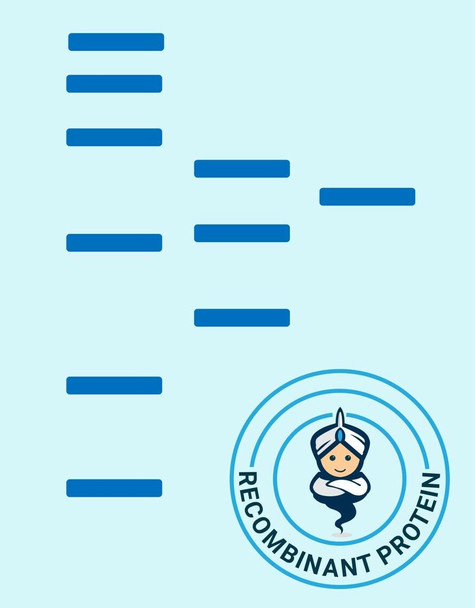Description
| Product Name: | Mouse LGALS1 Recombinant Protein |
| Product Code: | RPPB0274 |
| Size: | 20µg |
| Species: | Mouse |
| Target: | LGALS1 |
| Synonyms: | Galectin-1, Gal-1, 14 kDa lectin, Beta-galactoside-binding lectin L-14-I, Galaptin, Lactose-binding lectin 1, Lectin galactoside-binding soluble 1, S-Lac lectin 1, Lgals1, Gbp, L14, Galbp, L-14.5, Lect14, AA410090. |
| Source: | Escherichia Coli |
| Physical Appearance: | Sterile Filtered colorless solution. |
| Formulation: | The LGALS1 solution (1mg/ml) contains 20mM Tris-HCl buffer (pH 8.0), 0.15M NaCl and 10% glycerol. |
| Stability: | Store at 4°C if entire vial will be used within 2-4 weeks. Store, frozen at -20°C for longer periods of time. For long term storage it is recommended to add a carrier protein (0.1% HSA or BSA).Avoid multiple freeze-thaw cycles. |
| Purity: | Greater than 95.0% as determined by SDS-PAGE. |
| Amino Acid Sequence: | MGSSHHHHHH SSGLVPRGSH MGSHMACGLV ASNLNLKPGE CLKVRGEVAS DAKSFVLNLG KDSNNLCLHF NPRFNAHGDA NTIVCNTKED GTWGTEHREP AFPFQPGSIT EVCITFDQAD LTIKLPDGHE FKFPNRLNME AINYMAADGD FKIKCVAFE |
The galectins are a family of beta-galactoside-binding proteins implicated in modulating cell-cell and cell-matrix interactions. Galectin-1 is an autocrine negative growth factor that regulates cell proliferation. Galectin-1 regulates cell apoptosis and cell differentiation. Galectin-1 binds CD45, CD3 and CD4 & inhibits CD45 protein phosphatase activity and therefore the dephosphorylation of lyn kinase. Galectin-1 and its ligands are one of the master regulators of immune responses as T-cell homeostasis and survival, T-cell immune disorders, inflammation and allergies as well as host�pathogen interactions. Galectin-1 expression or overexpression in tumors and/or the tissue surrounding them must be considered as a sign of the malignant tumor progression that is often related to the long-range dissemination of tumoral cells (metastasis), to their dissemination into the surrounding normal tissue, and to tumor immune-escape. Galectin-1 in its oxidized form plays a number of important roles in the regeneration of the central nervous system after injury. The targeted overexpression (or delivery) of Galectin-1 should be considered as a method of choice for the treatment of some kinds of inflammation-related diseases, neurodegenerative pathologies and muscular dystrophies. In contrast, the targeted inhibition of Galectin-1 expression is what should be developed for therapeutic applications against cancer progression. Galectin-1 is thus a promising molecular target for the development of new and original therapeutic tools. There is 88% homology between the human and mouse galectin-1.
LGALS1 mouse Recombinant produced E. coli is a single polypeptide chain containing 159 amino acids (1-135) and having a molecular mass of 17kDa.LGALS1 is fused to a 24 amino acid His-tag at N-terminus & purified by proprietary chromatographic techniques.
| UniProt Protein Function: | Galectin-1: May regulate apoptosis, cell proliferation and cell differentiation. Binds beta-galactoside and a wide array of complex carbohydrates. Inhibits CD45 protein phosphatase activity and therefore the dephosphorylation of Lyn kinase. Homodimer. Binds LGALS3BP. Interacts with CD2, CD3, CD4, CD7, CD43 and CD45. Interacts with laminin (via poly-N- acetyllactosamine). Expressed in placenta, maternal decidua and fetal membranes. Within placenta, expressed in trophoblasts, stromal cells, villous endothelium, syncytiotrophoblast apical membrane and villous stroma. Within fetal membranes, expressed in amnion, chorioamniotic mesenchyma and chorion. Expressed in cardiac, smooth, and skeletal muscle, neurons, thymus, kidney and hematopoietic cells. |
| UniProt Protein Details: | Protein type:Cell adhesion Cellular Component: extracellular matrix; proteinaceous extracellular matrix; extracellular space; cell surface; cytoplasm; extracellular region; intracellular; nucleus Molecular Function:signal transducer activity; protein binding; protein homodimerization activity; lactose binding; galactose binding; laminin binding; galactoside binding; carbohydrate binding; glycoprotein binding Biological Process: heterophilic cell adhesion; myoblast differentiation; positive regulation of I-kappaB kinase/NF-kappaB cascade; plasma cell differentiation; apoptosis; T cell costimulation; positive regulation of erythrocyte aggregation; signal transduction |
| UniProt Code: | P16045 |
| NCBI GenInfo Identifier: | 126172 |
| NCBI Gene ID: | 16852 |
| NCBI Accession: | P16045.3 |
| UniProt Secondary Accession: | P16045,P05163, P11946, P17601, Q4FZH4, Q99M27, Q9D0X0 |
| UniProt Related Accession: | P16045 |
| Molecular Weight: | 14,866 Da |
| NCBI Full Name: | Galectin-1 |
| NCBI Synonym Full Names: | lectin, galactose binding, soluble 1 |
| NCBI Official Symbol: | Lgals1�� |
| NCBI Official Synonym Symbols: | L14; Gal-1; Galbp; L-14.5; Lect14; AA410090; galectin-1�� |
| NCBI Protein Information: | galectin-1; galaptin; 14 kDa lectin; S-Lac lectin 1; lactose-binding lectin 1; beta-galactoside binding protein; lectin galactoside-binding soluble 1; beta-galactoside-binding lectin L-14-I |
| UniProt Protein Name: | Galectin-1 |
| UniProt Synonym Protein Names: | 14 kDa lectin; Beta-galactoside-binding lectin L-14-I; Galaptin; Lactose-binding lectin 1; Lectin galactoside-binding soluble 1; S-Lac lectin 1 |
| Protein Family: | Galectin |
| UniProt Gene Name: | Lgals1�� |
| UniProt Entry Name: | LEG1_MOUSE |






